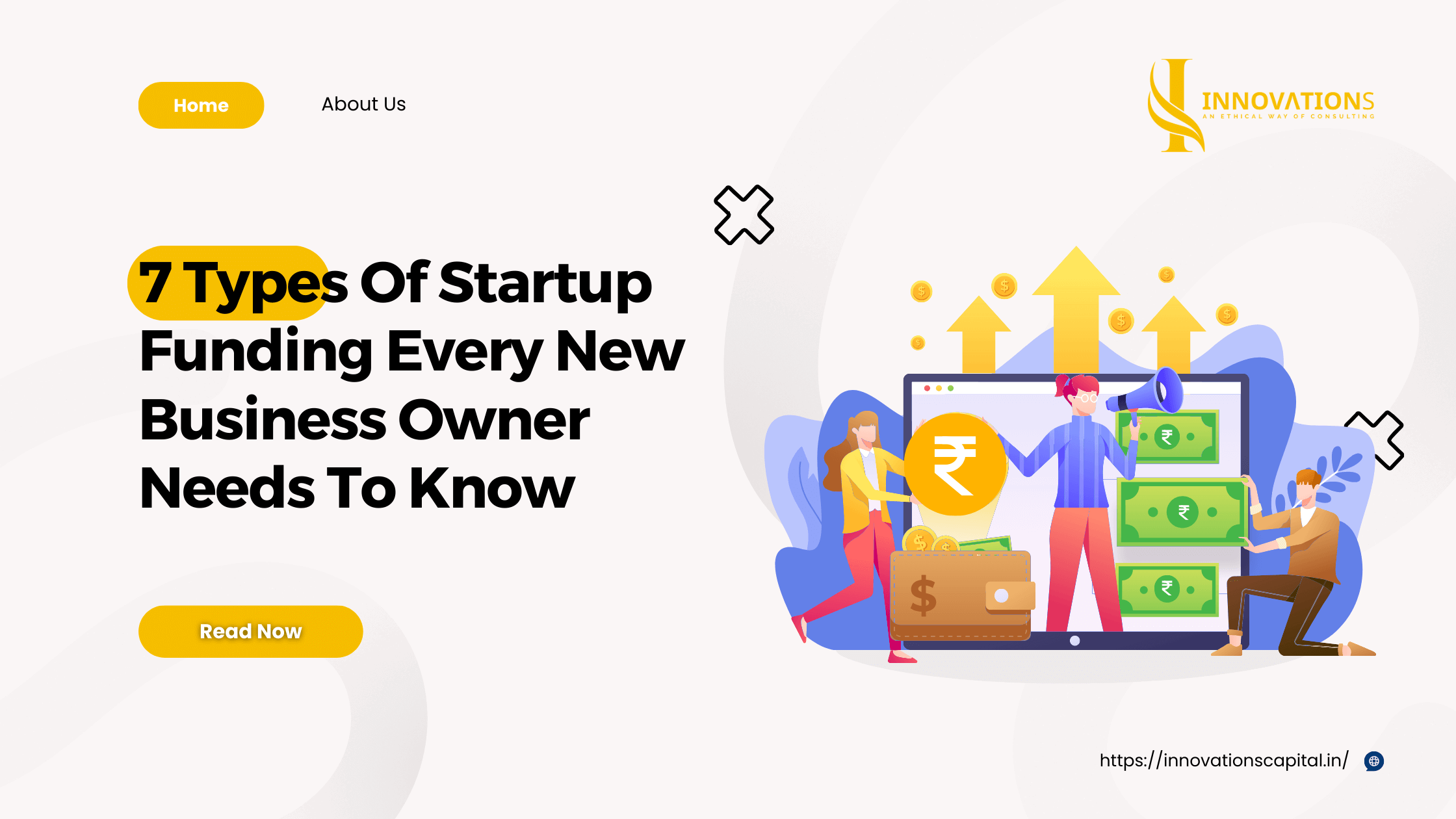Introduction:
Securing funding is a critical challenge for new business owners, particularly in the competitive landscape of today’s entrepreneurial environment. One major hurdle is the lack of a proven track record, as many investors are risk-averse and prefer to invest in established businesses with a demonstrated history of success. Additionally, new entrepreneurs often struggle to accurately assess and communicate the potential of their business idea, making it challenging to attract the interest of investors. The absence of collateral and a limited credit history can also hinder access to traditional financing options, leaving many new business owners exploring the different types of startup funding for their business.
Startup funding is vital for turning innovative ideas into products. Securing funds validates the business concept, fostering confidence and opening doors to growth and success.
Innovations Venture Studio is a pivotal resource for entrepreneurs seeking capital. The firm offers unwavering support, providing access to collective networks and expertise, fostering a community of like-minded founders. With a focus on catalyzing startup funding, the studio employs expert guidance, mentorship, and an extensive investor network.
Seasoned mentors enhance business models, shared resources optimize operational costs, and proof of concepts is developed to fortify investment cases. Additionally, participation in readiness programs equips startups with essential skills, ensuring successful navigation of the funding landscape and facilitating exceptional outcomes for entrepreneurs leveraging the studio’s capital resources.
Startup Funding Types Every New Business Owner Know:

In this section, we will provide an in-depth look at each of the 7 types of funding for startups – series funding, bootstrapping funds, angel investors, venture capital funding model, crowdfunding, corporate partnerships and government grants and subsidies for startups. With a clear understanding of how each model works.
Series Funding :
Series funding is a sequential capital-raising process for startups, progressing from seed funding to Series A, B, C and beyond. Investors provide funds in exchange for equity, fueling essential aspects like product development and marketing. Each series marks a distinct phase in the startup’s evolution, aiming to achieve milestones, demonstrate growth, and attract increased valuation. Series A through E represent key funding stages.
Series A is a pivotal step in a startup’s journey, following angel investment or seed funding. It aims to evaluate product-market fit, establish a team, and scale the business.
By series B funding you should have proven your concept and focus on scaling the business, expanding in new markets and developing new products and services.
Series C funding is typically used to prepare the company for an IPO or acquisition, international expansion and new product development.
Series D and E funding involves funding through venture capital firms, private equity firms and sovereign wealth funds. These funding paths are uncommon and usually used by companies that are rapidly expanding and pursuing new opportunities.
Bootstrapping and Personal Funds:
Bootstrapping, often regarded as the epitome of self-reliance, involves entrepreneurs relying on personal funds and revenue generation to fuel their startup’s growth. The allure lies in the autonomy it affords, allowing founders to chart their course without external interference. However, this journey is not without its challenges. Limited resources and slower growth become inherent obstacles that require strategic navigation.
Successful bootstrapping is an art that involves minimizing expenses and laser-focused revenue generation. Lean operations, strategic partnerships, and a meticulous approach to resource utilization become the guiding principles for entrepreneurs navigating the bootstrapping route.
Angel Investors:

Angel investors, aptly named for their role as benevolent supporters, are typically seasoned entrepreneurs or professionals who inject capital into startups in exchange for equity. Attracting and pitching to angel investors is an art that extends beyond financial considerations. The advantages go beyond the monetary influx, offering startups access to a wealth of expertise and expansive networks.
The process of securing angel investment involves effective pitching and due diligence. Crafting a compelling narrative that aligns with the investor’s values and aspirations is key. The symbiotic relationship formed in this funding avenue often becomes a catalyst for long-term success.
One really successful endeavor by angel investment is Google, who was backed by Ram Shriram as one of the first investors. His initial investment was $1,00,000-$2,00,000 dollars and now owns 2.8 million shares. At the time of writing this article, Google’s per share price is as high as $148.
Venture Capital Funding Model:
Venture capital (VC) firms, known for their risk appetite, play a pivotal role in shaping the trajectory of high-potential startups. The venture capital funding model involves significant capital injection in exchange for equity, usually 20-30 percent. While this model brings substantial benefits such as strategic guidance and networking opportunities, startups face challenges like relinquishing control and meeting aggressive growth targets set by the VC firms. They often acquire voting rights in company decisions and a position on the board of directors. After the business is successful, the VC companies usually sell their shares to other interested parties or in the market, gaining high returns.
Understanding the criteria VC firms look for in startups becomes crucial for entrepreneurs seeking this funding avenue. VCs often look for teams that are passionate and confident about their product or service and have gone through the ‘Bootstrap’ period as this signifies that they can go through all the hurdles that company might face in the future. Alignment with the VC’s strategic goals and a robust plan for exponential growth are prerequisites for successfully navigating the venture capital landscape.
Crowdfunding:
In the age of digital connectivity, crowdfunding has emerged as a democratized funding model. It encompasses various models.
Peer to peer lending involves borrowing money from the crowd and repaying it with interest. The equity system of crowdfunding involves sale of stake in a business to a number of investors in return for investment. Rewards based crowdfunding involves individuals funding the business in return for non-financial rewards at a later stage in exchange of their contribution. Donation based crowdfunding involves individuals donating money for a specific business without any expectation of return. Profit sharing involves sharing profits or revenues with the crowd in return of their investment whereas in debt security individuals invest in a debt security issued by the company such as bonds. Hybrid models involve elements from more than one model.
Running a successful crowdfunding campaign is an art that involves not only financial considerations but also community building.
Tips for a successful crowdfunding campaign range from crafting compelling stories to leveraging social media effectively. However, challenges such as setting realistic funding goals and navigating the dynamics of diverse backers necessitate careful planning.
Popsocket, began its crowdfunding through kickstarter in 2012 and since then it is one of the most successful crowdfunded businesses. Its peak revenue in 2022 was 3.6 million dollars.
Government Grants and Subsidies For Startups:

India offers support programs in the form of grants and subsidies like – Startup India scheme, Atal innovation mission, Standup India, Pradhan Mantri Mudra Yojna etc. One of the best schemes for startups is the startup india seed fund scheme. These schemes provide the businesses with technical assistance, financial assistance and subsidies among other facilities.
In order to be eligible for the Startup India scheme, the startup should be a registered partnership firm, private limited company, or LLP. Besides, its turnover shouldn’t exceed 100 crores in previous financial years. The startup must also apply within ten years from the date of formation.
For startups with a focus on research and development, government grants become a beacon of support, allowing them to innovate without the immediate pressure of returns.
Corporate Partnerships:
Beyond traditional funding avenues, startups can explore synergies with established companies through corporate partnerships. These partnerships transcend financial support, offering startups access to resources, market insights, and established networks.
Navigating corporate partnerships involves strategic alignment of goals and a clear understanding of what each party brings to the table. This symbiotic relationship can propel startups to new heights, leveraging the strengths of both the nimble startup and the established corporate entity.
How to Choose the Right Funding Option for Your Startup
Choosing the right funding strategy for your startup requires a thorough assessment of factors such as alignment with long-term business goals, funding amount and timing, control and equity dilution preferences, risk tolerance, and the value of the network and support offered by different funding sources. It’s crucial to weigh the trade-offs between control and growth potential, considering the risks associated with each option. Seeking expert advice from fundraising consultants can provide valuable insights, helping you make informed decisions tailored to your specific circumstances. Assess the strategic value of investors beyond financial contributions, considering factors like mentorship, industry connections, and expertise. Ultimately, a well-rounded evaluation considering these aspects will maximize the likelihood of achieving your milestones and ensuring the success of your startup.
Conclusion:
In conclusion, navigating the diverse landscape of startup funding in India demands a nuanced understanding of the available options and a strategic alignment with your business goals. Whether opting for the self-reliance of bootstrapping, leveraging the expertise of angel investors, embracing the risk and guidance from venture capitalists, harnessing the power of crowdfunding, tapping into government grants, or forging symbiotic relationships through corporate partnerships, each avenue comes with its own set of challenges and opportunities. The key lies in a comprehensive evaluation of factors such as risk tolerance, growth potential, and the intrinsic value brought by investors or partners. By carefully considering these elements and seeking expert advice, entrepreneurs can chart a course through the intricate funding terrain, turning their visionary ideas into thriving, sustainable businesses in the dynamic startup ecosystem of India.
Elevate your startup with Innovations Venture Studio. Our seasoned mentors and extensive network are ready to guide you. Connect with us for refined business models, shared resources, and a strengthened investment case. Propel your startup to new heights – choose Innovations Venture Studio as your professional advisor.

